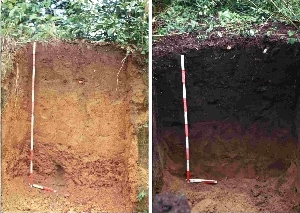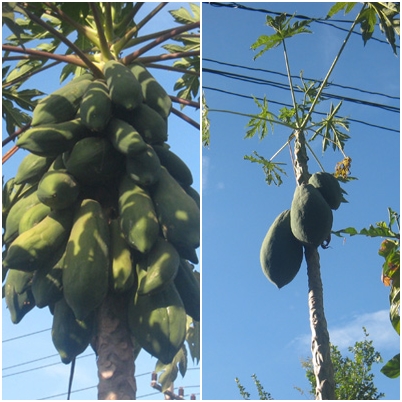
I’m experimenting with a passive compost trench system along the sides of our forest garden beds. The bean borders/compost trenches are primarily for erosion control, building soil, boosting the worm population and suppressing weeds. Secondary benefits include beans for seed and food, attracting pollinators, and benefiting nearby plants with extra nitrogen and water. The bean/vetiver/compost borders also look really good. In a few years the vetiver will grow into 12” clumps and form a continuous hedge, which will provide a continual source of nutrient rich green manure.
compost
Compost in Place

People have asked about our lack of compost piles and bins at our new homestead. Here’s an overview of the composting method we’re using on our forest garden. Compost happens no matter what approach you use. We prefer no till gardening — get out of the way and let nature take care of things. Simply spread soil amendments on the garden as time and money allow and then let it break down naturally. The following article from Dave’s Garden explains the process in more detail.
More Details about Terra Preta

I’m really fascinated with the terra preta/biochar concept. We briefly touched on the subject in our blog post Big Ideas that are Changing the World. Watch the excellent video there for a good overview of the subject.
Terra preta is nothing short of amazing. It’s considered the most fertile soil in the world, and has retained its fertility over thousands of years. Studies have reported positive effects from biochar on crop production in degraded and nutrient–poor soils. Biochar–enhanced soils can indefinitely sustain agricultural production [that means forever!], whereas non-amended soils quickly become depleted of nutrients. Compare terra preta to modern industrial agriculture that gradually depletes soil and pollutes groundwater and food sources with toxic chemicals.
Fertilizer Can Make a Huge Difference

Yesterday’s blog post discussed various ways of boosting plant growth with liquid fertilizers. Well, a picture is worth a thousand words and so we took some photos of local papaya fruit trees to show what a difference proper fertilization can make. The EM fertilized papaya tree on the far left obviously received the nutrients it needed to be a prolific producer. I counted roughly 20 fruits. This papaya tree is in marginal soil and yet still prolific.
Liquid Fertilizers for Organic Gardening
The soil in most parts of the world has been depleted through intensive farming methods and erosion. Plants will grow with chemical fertilizer, but often lack valuable minerals and micronutrients. We need to give the plants a boost so they’re healthy and disease resistant, and our bodies also need the added nutrients. This blog post explains several low cost/free ways to make liquid fertilizer to give your plants a healthy, natural boost. And remember, “You are what you eat” (and think).
EM = effective organisms, microbial innoculent
Jean Pain’s Compost-based Bioenergy System
“Jean Pain (1930–1981) was a French innovator who developed a compost-based bioenergy system that produced 100% of his energy needs. He heated water to 60 degrees celsius at a rate of 4 litres a minute which he used for washing and heating. He also distilled enough methane to run an electricity generator, cooking elements, and power his truck. This method of creating usable energy from composting materials has come to be known as Jean Pain Composting, or the Jean Pain Method.
